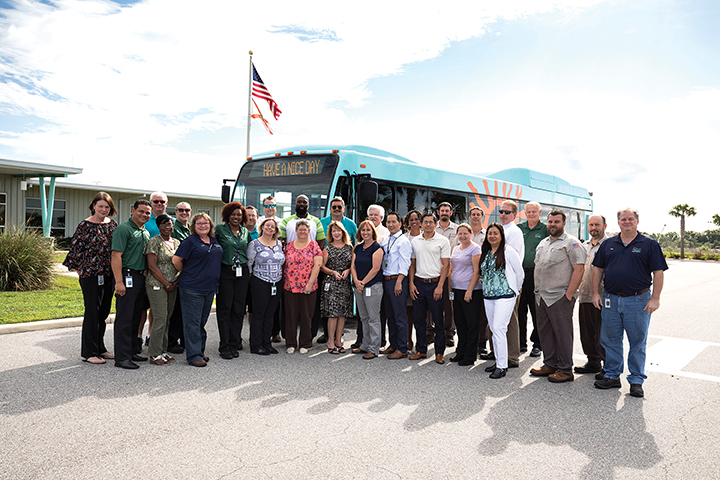
Manatee County Area Transit (MCAT) provides public transportation to a ridership of over 2 million in Manatee County, serving Bradenton, Ellenton, Palmetto and several Gulf Beach communities along Florida’s West Coast. The MCAT service is now enhanced with the addition of the Q’POD and QUANTUM wheelchair securement systems provided by Q’Straint.
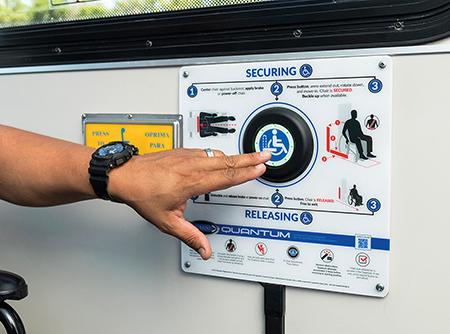
Securing connections
The relationship between the agency and Q’Straint began when Manatee County Government Transit Division Manager William Steele and Manatee County’s Transit Operations Chief Jim Egbert observed the QUANTUM system demonstration at the 2016 Florida Public Transportation Association (FPTA) Conference.
“I previously worked at the Pinellas Suncoast Transit Authority (PSTA) in the Safety, Security and Training Division, and PSTA upgraded to the Q’POD system on a new bus order, and when I moved to MCAT, they were in the process of ordering buses and I noticed they had specified a four-point wheelchair securement system,” Egbert says. “Fortunately, it was not too late to initiate a change order and specify the more advanced Q’POD securement system. I saw the QUANTUM demonstration soon thereafter, and since then, I was looking for every possible way to get the QUANTUM system on our buses. ”
Egbert and Steele expressed their interest in learning more, and scheduled Q’Straint for an on-site presentation for both the MCAT leadership team and transit operators. Both the MCAT leadership team and operators asked very specific questions about how the new wheelchair securement technology could benefit operations and passengers. In short, creating a real “win-win” for the community.
This very focused and engaged interaction provides the important in-person forum, where any operational concerns are addressed right up front, and not during the pilot program. Understanding how the equipment functions, and addressing the “what-ifs,” put the operations team at ease, and both the Operators and Supervisors saw the program potential from the outset.
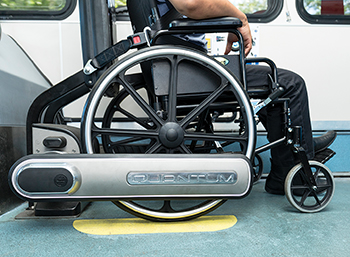
After initial buy-in from the MCAT “team,” a community outreach forum was scheduled to judge the interest from MCAT customers. Surveys completed by customers confirmed their interest in the state-of-the-art wheelchair securement technology, and the potential benefits of the pilot program. The MCAT team then involved their Public Works Department leadership; and from that point forward, it was clear that everyone involved favored a six-month Field Evaluation Pilot Program.
“Prior to the installation, Q’Straint demonstrated the QUANTUM equipment to the MCAT ridership at the Downtown Bradenton Transit Station,” says Mitch Drouillard, southern regional manager for Q’Straint and Sure-Lok. “Educating the community about the benefits of rear-facing wheelchair securement and how QUANTUM is beneficial to everyone riding the bus, is critical. The Q’Straint team also provided extensive on-site education and training to address any potential MCAT operations issues or questions, before the QUANTUM pilot is underway, and the securement system is utilized in service delivery.”
“The entire process, from the initial presentation to the completed QUANTUM system installation, took approximately three months,” says William Steele, Manatee County’s transit division manager. “This fast pace is a testament to both Manatee County Government and Q’Straint, as all parties took the pilot program very seriously, and everyone agreed that it is important to gauge the impact of this technology in service delivery operations.”
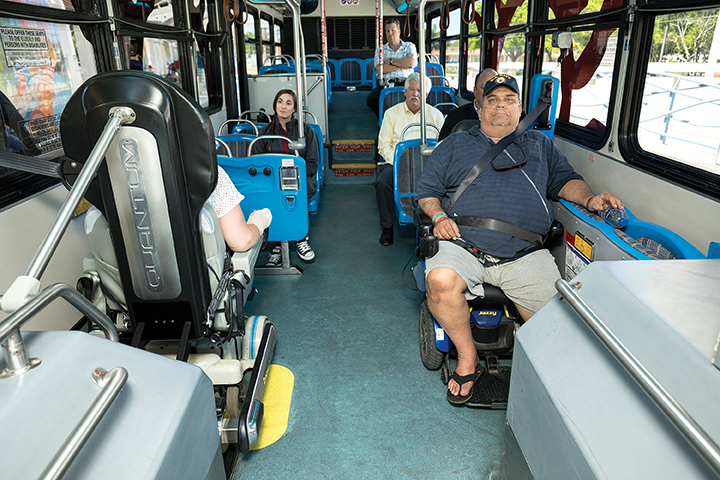
The systems in action
QUANTUM by Q’Straint is transit’s first fully-automatic rear-facing wheelchair securement station. Passengers back their wheelchairs or scooters into the system, press a button and independently secure themselves. QUANTUM’s side-arm lowers and hugs the wheel, safely securing the wheelchair with minimal operator assistance. If the passenger is not able to push the occupant button independently, the bus operator can push the button located on the dash – securing or releasing the passenger without leaving the driver’s seat.
Q’POD is the industry’s first fully-integrated forward-facing wheelchair securement station specifically designed and tested for transit wheelchair passenger transportation. The system bolts directly into a bus, and its integrated shoulder belt eliminates the need for window brackets. Its stabilizing bumper works with the front tensioner and scooter ring – which allows for three-point securement and less aisle way trip hazards.
“Q’POD and QUANTUM offer MCAT the latest technology in forward- and rear-facing wheelchair securement,” Drouillard says. “Both systems reduce dwell times by significantly speeding up the wheelchair securement process, which can often take up to five minutes to complete.”
According to Q’Straint, the QUANTUM system can secure a wheelchair in less than 25 seconds; from when the passenger pushes the occupant-secure button to final securement. The Q’POD reduces a four-point system’s securement time by half.
“This is so important because not only does it help the operator maintain the route schedule, it also reduces liability by providing a safe and easy method to secure difficult mobility devices,” Drouillard says.
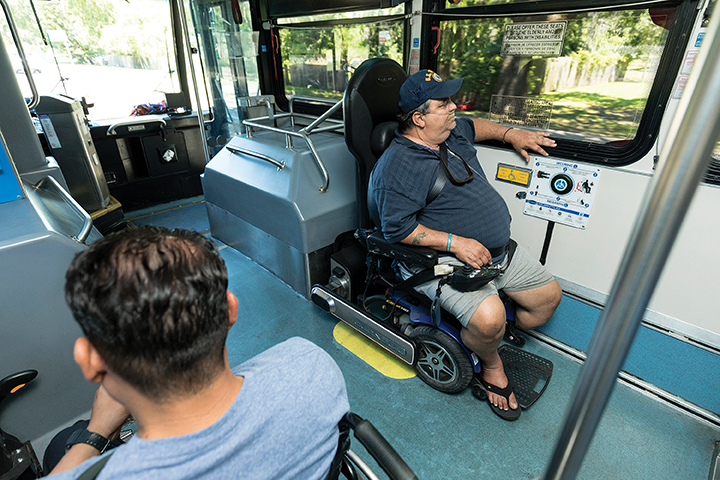
Installation and training
The QUANTUM was installed as a retrofit to an existing MCAT 35-foot bus. Typically, theatre style flip seats are selected for passenger use in this area and will most likely be added on new bus builds moving forward.
In addition to hands-on training for the operators and route supervisors, Q’Straint also provided maintenance training for MCAT fleet technicians. The Q’Straint and MCAT teams took great measures prior to the installation to address any concerns regarding this new technology. Educating the ridership and MCAT staff on the front-end is the key reason for the positive acceptance at all levels.
“I have always found the Q’Straint staff to be friendly and easy to work with,” Egbert says. “They always come with a friendly, positive, and helpful attitude. Their team made sure that MCAT staff fully understood everything needed for successful operation of these securement systems.”
Constituent feedback
Egbert says that first-time QUANTUM users are sometimes skeptical, as self-securement is a brand-new concept. Their first fear, he says, is of riding while rear facing. However, after using the system, passengers express their belief that this system offers a new sense of independence and another level of normalcy, when compared to transit ambulatory boarding passengers.
“They enjoy the fact that they now have the independence to board and complete the wheelchair securement process on their own, without relying on the bus operator,” he says. “Furthermore, wheelchair passengers no longer feel as though other passengers are blaming them for delaying the bus and maybe even running late.”
He says that MCAT operators love the QUANTUM, because it allows them to stay in their seats while passengers self-secure their wheelchair device. Egbert says the Q’POD is also “a big hit,” as it’s a time saver and less invasive to the wheelchair passenger’s personal space, while providing a higher level of wheelchair securement during travel.
Transforming the transit experience
“The QUANTUM is a great win in many ways for Manatee County Government and especially MCAT,” he says. “For transit operations, it provides better schedule adherence, and for potential safety issues and liability concerns, wheelchair tip-overs are completely eliminated. Q’Straint is the only wheelchair securement system I’ve ever known during my 35 years in the transit industry. With the company’s defining state-of-the-art equipment, high standards in new product development, and the ability to work effectively with transit agencies during new product development, there is simply no need to look elsewhere.”
